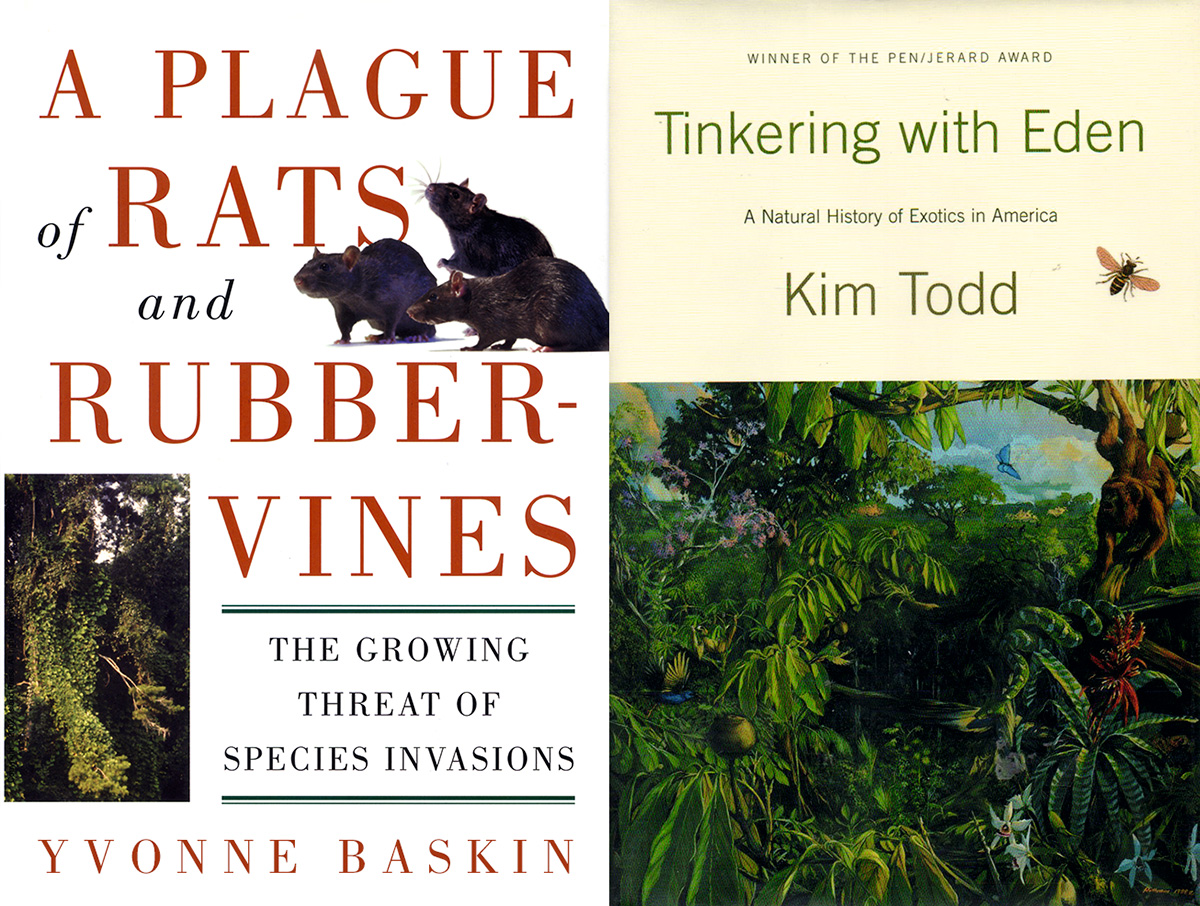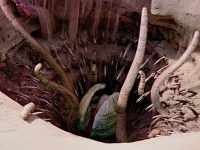Defining nature
Competing perspectives: Between nativism and ecological novelty

In the 1980s, three sub-disciplines of ecology emerged – restoration ecology, conservation biology, and invasion biology – and all three embraced the nativism paradigm. By the early 2000s, historians, sociologists, and philosophers interested in the development of science began to examine the growing field of invasion biology and usually were critical of it. In the past few years, a new perspective has been taking hold in the field of ecology. Referred to as ecological novelty it emphasizes that many factors are producing ecologically novel environments. A much more simply descriptive concept, it is currently competing with the nativism paradigm to define nature. Whether the nativism or ecological novelty paradigm emerges as the dominant perspective going forward will determine how nature and biodiversity are managed.
Keywords: nativism, ecological novelty, nature, nonnative species, invasion biology.
«In the classical nativism paradigm, origin is pre-eminent, newcomers are vilified, and war is declared on the newomers»
In 1996, environmental historian William Cronon edited a watershed book, Uncommon ground: Rethinking the human place in nature. Cronon wrote the foreword, introduction, and first chapter, in which he challenged the common view of nature and wilderness. Specifically, he argued that what we thought of as nature was actually just an idea (Cronon, 1996, p. 20), one arising out of our cultural assumptions (Cronon, 1996, p. 26), influenced by the particular place and times in which we lived. In other words, «nature» does not really exist outside of our minds. Animals, trees, lakes, and rocks certainly exist, but «nature» and «wilderness» are ideas. Cronon argued that the western view of Nature, and the North American perspective in particular, embodied nature with a pristine-like quality to which humans can only pollute (Cronon, 1996, p. 83; Figure 1). Because most Americans at the time viewed nature and wilderness as the epitome of reality, places on Earth little impacted by humans, Cronon’s critique was controversial and not well-received by many environmentalists.
«In the 1980s, species introduced from other areas of the world were declared as invaders»
While Cronon’s book eventually proved to be transformative in the field of environmental history, it had little effect in the scientific field of ecology. There is little evidence that it prompted much awareness of the role of cultural values in developing ecological ideas. Evidence that Cronon’s critique did not gain much traction in the field of ecology is the development of the nativism paradigm in ecology in the 1980s, in which species introduced from other areas of the world were declared as «invaders», «exotics», «aliens», and «biological pollution». During the 1980s and much of the 90s, it did not matter if the species spread widely and caused great harm or were comparatively sedentary and benign. All introduced species were deemed «invaders». This was a classical nativism paradigm, in which origin is pre-eminent, newcomers are vilified, and war is declared on the newcomers in efforts to eradicate them (Figure 2).

Figure 2. An example of the militaristic approach taken toward the management of nonnative species. This kind of approach tends to use a language which includes references to war, battle, or fight against the enemy.
The emergence of ecology’s three sisters
In the 1980s, three sub-disciplines of ecology emerged – restoration ecology, conservation biology, and invasion biology – and all three embraced the nativism paradigm. Restoration in the United States meant returning environments to some point in the past, which usually meant just prior to the colonization of a site by Europeans. This involved explicit efforts to rid the area of non-native species and populating the environment only with native species. In 1994 the Society for Ecological Restoration proclaimed: «Ideally, a restoration project should consist entirely of indigenous species.» Conservation biology similarly put its emphasis on conserving native species and eradicating nonnative species. Conservationist Stanley Temple wrote an editorial in the journal Conservation Biology in 1990 titled, «The nasty necessity: Eradicating exotics» (Temple, 1990). In the editorial, Temple wrote: «Conservation biologists should be as proficient at eradicating exotic species as they are at saving endangered species.» And invasion biology provided the nativism narrative for these two fields. Biodiversity was important for the three sisters but only if it was native biodiversity.
Early on, the biologist Michael Soulé predicted the development of a new industry grounded in the nativism paradigm. In 1989, in his presidential talk to the Society for Conservation Biology, Soulé stated that «the control of exotics is a growth industry». He added: «The bad news is that there will once again be calls for the widespread application of herbicides, insecticides, and rodenticides.» (Soulé, 1990). While the war against invasive species has not developed into anything like the military-industrial complex, it has emerged as an organized, concerted, international effort consisting of an odd group of bedfellows, including chemical companies; restoration and land management companies; environmental groups (which could use the war on invasive species in their efforts to raise money); local, state and federal agencies, who similarly were able to use the «onslaught» of the invaders as a way to request additional funds and expand their footprint; and even academics, many of whom developed their professional identities as invasion scientists.
«Recent assessments at the global level have listed invasive species as a relatively minor biodiversity threat worldwide»
The titles of books written by scientists and science writers reveals the underlying emphasis on purity and origins in the fields of restoration ecology, conservation biology, and invasion ecology. Examples include A plague of rats and rubbervines, Nature out of place, Tinkering with Eden: A natural history of exotic species in America, and Strangers in paradise (Figure 3).

Figure 3. Examples of books whose titles embraced the nativism paradigm. This conception of nature, developed in ecology in the 1980s, caused species introduced from other areas of the world to be declared as «invaders», «exotics», «aliens», and «biological pollution».
Why the eagerness to embrace nativisim?
Many students of the evolution of human behavior believe that humans are predisposed to think in a binary fashion, in particular to divide people into two groups: us and them. Often referred to as parochial altruism (Bernhard, Fischbacher, & Fehr, 2006; Choi & Bowles, 2007), this behavior consists of assisting and favoring members of one’s group while opposing and often vilifying members outside the group. Today, this behavior is frequently described as tribalistic. Nativism, whether involving people or other species, is fundamentally tribalistic in nature. If humans are predisposed to think in a tribalistic way, it is not surprising that ecologists and most of the public were quick to embrace native species while denigrating nonnatives.
Nostalgia usually plays a role in the emergence of nativism/tribalism perspectives, particularly when people are experiencing very rapid change. In her book The future of nostalgia, humanist Svetlana Boym argued that «nostalgia tries to slow down time» and observed that people exhibited one of two types of nostalgia in response to rapid change: reflective nostalgia and restorative nostalgia (Boym, 2001). In Boym’s words, reflective nostalgia involves acknowledging the past and using the past as a resource to guide one’s current options, but it does not try or hope to restore the past. In contrast, restorative nostalgia involves a desire to return to or revive the past. Restorative nostalgia is about «heritage and tradition» although «it’s often an invented tradition – a dogmatic, stable myth that gives you a coherent version of the past». In Boym’s scheme, nativism can be viewed as an expression of restorative nostalgia, a response to the recent and ongoing very rapid mixing of the Earth’s flora and fauna.
We are certainly experiencing an ever-increasing rate of cosmopolitanization. People, cultures, and other species are moving, or being moved, around the world at an unprecedented pace. For most of us, the world in which we grew up does not exist anymore, and this includes not only the town and neighborhoods in which we lived, but also the forests, grasslands, lakes, and other habitats we may have frequented growing up. Rapid change, whether ecological or cultural/political, can be anxiety producing and the emergence of nativist and nationalistic movements is not surprising.
«In the past few years, a new perspective has been taking hold in the field of ecology, referred to as “ecological novelty”»
Interestingly, it is the ecologists who have had the most difficulty adjusting to the spread of species around the world. This too was predicted by Soulé, who, in his 1989 address, observed that «as the number of exotics in most regions produces a cosmopolitanization of remnant wildlands, there will be an agonizing period of transition, especially for ecologists.» He went on, «For many North American ecologists, the psychological adjustment to biogeographically recombined communities will be painful.»
Pushback
By the early 2000s, historians, sociologists, philosophers, and humanists interested in the development of science began to examine the growing field of invasion biology and usually were critical of it (Chew & Laubichler, 2003; Larson, 2005; Sagoff, 1999). They pointed out the extreme normative aspects of the field, in which the starting point was that native species are desirable while nonnatives were not. They also pointed out invasion biologists’ frequent use of hyperbole, militaristic language, and misrepresentation of data. A 1998 paper describing threats to biodiversity in the United States concluded that invasive species were the second largest threat, behind habitat loss (Wilcove, Rothstein, Dubow, Phillips, & Losos, 1998). However, the data were terribly skewed by the inclusion of Hawaii in the analysis. While Hawaii is part of the United States, its biogeography as a remote set of islands has little in similarity to the continental US. In fact, introduced species have been a major cause of species extinctions on islands, particularly introduced predators and pathogens, which was the case in Hawaii. However, when Hawaii was deleted from the analysis, introduced species dropped to near the bottom of threats. Nevertheless, this paper has been cited in the scientific literature more than 2,000 times to support the false claim that introduced species are the second greatest threat to biodiversity world-wide. While introduced species can be great threats to biodiversity on islands and some insular freshwater environments, recent assessments at the global level have listed invasive species as a relatively minor biodiversity threat worldwide, compared to habitat loss, land-use change, over-harvesting, and climate change (WWF, 2014).
The nativism paradigm may have been first criticized broadly to the public in a 1994 article written by Michael Pollan, titled «Against nativism», and published in The New York Times Magazine (Pollan, 1994). Pollan observed that «intolerance toward foreign species seems to be rising in the natural-gardening movement». He cautioned that «we would do well to beware of ideology in the garden masquerading as science» and closed his article calling for gardeners to embrace multihorticulturalism. Renowned paleontologist and evolutionary biologist Stephen Jay Gould made clear his views on the nativism paradigm in a 1998 article in the journal Arnoldia (Gould, 1998). Writing about applying the nativism paradigm to plants, he wrote that a dichotomous paradigm seldom adequately describes nature and that, from an evolutionary perspective, «“native” plants cannot be deemed biologically best in any justifiable way». More recently, nineteen scientists published an article in the journal Nature calling for conservationists to focus much more on the functions of species, and much less on where they originated (Davis et al., 2011).
In the United States the general public also has begun to push back against some efforts to restore native environments, particularly large-scale efforts and those involving the use of chemicals or heavy machinery. A recent example is the rallying of San Francisco residents to stop a city plan to kill most of the eucalyptus trees and replace them with native species on Mount Sutro, a forested city park. Besides the concerns for the planned use of chemicals and heavy equipment to execute this plan, citizens opposed the removal of the eucalyptus trees for personal reasons. The fact was that the nonnative trees were older than virtually anyone alive, and thus ironically the nonnative trees contributed to the citizens’ sense of place. In the end, the citizens’ efforts resulted in a considerably modified restoration plan.
The field of invasion biology has matured in recent years and now the United States assigns the word invasive to species that cause harm, including harm to humans, economic harm, and ecological harm. Usually there is little disagreement over what constitutes harm in the first two categories, but ecological harm is in the eye of the beholder. What someone might consider ecological harm someone else may view simply as ecological change, even sometimes desirable change. For example, does a simple decline in the abundance of a native species and the addition of a new species into the environment constitute harm or change? Assuming this change does not threaten human health or the economy or any ecological services the environment may be providing us, the question cannot be answered by science. It is a value-based matter of preference.

Figure 4. The Sutro Forest in San Francisco (USA) is a good example
of a novel ecosystem. It is a thriving mix of native and non-native
species. / © Rupa Bose
It makes sense to try to prevent ostensibly harmful species from being brought into a country or state if the effort is not too costly and it has a reasonably good chance of succeeding. The problem of declaring something as harmful once it has been introduced to a new region and has spread widely is this commits society to do something to mitigate the harm. Given that society has limited resources, it seldom has the luxury to try to manage the relative abundance of species, in other words to try to garden nature. Urban ecologists, in particular, are recognizing the inevitability of introduced species in urban areas. Peter Del Tredici emphasized that «in the absence of intensive horticultural maintenance, spontaneous vegetation [consisting of species of mixed origin] will eventually come to dominate most urban landscapes» (Del Tredici, 2010, p. 17). He also made the point (Del Tredici, 2010, p. 16) that «in an urban context, the concept of restoration is really just gardening dressed up to look like ecology». Urban ecologist Richard Forman (2014, p. 215) argued similarly: «Pulling out non-native plants near a massive “mother” source of dispersing seeds, […] areas covered by nonnatives, seems analogous to using a flyswatter among billions of mosquitoes. Or tilting with windmills à la Don Quixote.» Forman also pointed out not only the inevitability of non-native plants but their value: «In urban areas most native [plant] species cannot keep up with the rate of environmental changes, so a continual rain of new non-native species helps keep the [city] green» (Forman, 2014, p. 213).
Competition to define nature
Although the public may not be aware of it, there exists a heated competition to define nature. In the past few years, a new perspective has been taking hold in the field of ecology. Referred to as «ecological novelty» it emphasizes that many factors are producing ecologically novel environments (Hobbs et al., 2006). Climate change (which includes changes in temperatures and patterns of precipitation), increased atmospheric CO2, which affects photosynthetic rates, increased atmospheric deposition of nitrogen (the whole earth is being fertilized due to the increased nitrogen we are pouring into the atmosphere), and the introduction of new species are all rapidly changing our environments. A strength of the term ecological novelty is that unlike the invasion vocabulary it is only descriptive. It simply states that ecosystems are changing and are different than they were in the past, even the recent past. It says nothing about whether this change is good or bad. In this paradigm, species can be referred to as novel species, new arrivals, or long-term residents (Figure 4).
The less biased ecological novelty paradigm differs dramatically from the more value-based nativism paradigm. It differs in the language it uses, and it differs in that it does not point to a particular direction toward which land management should proceed. More generally, it forsakes the normative atmosphere that permeates restoration ecology, conservation biology, and invasion biology, all of which have been substantially guided by the nativism paradigm.
«A strength of the term ‘ecological novelty’ is that unlike the invasion vocabulary it is only descriptive»
Currently, invasion biologists have tried to discredit ecological novelty as a valid or valuable perspective in the fields of conservation biology and restoration ecology (Murcia et al., 2014). This is hardly surprising since the ecological novelty perspective has the potential to displace the nativism paradigm, and many stakeholders have much to lose if the nativism paradigm were abandoned, e.g., the same bedfellows described earlier. It has been more than thirty years since the three sisters of ecology emerged and now many people’s jobs, companies, and reputations are on the line. Not surprisingly, articles trying to shore up invasion ecology and to keep it relevant to conservation have been common in recent years.
Whether the nativism or ecological novelty paradigm emerges as the dominant perspective going forward will determine how nature is managed. Given that the redistribution of species is only going to increase in upcoming decades, it is hard to imagine that people will still be so preoccupied with origins by the middle of the century. Undoubtedly, nativist groups will still exist and will continue to try to restore their vision of the past. But, due to the number of species being moved to new regions, much more attention likely will be given to the function of species than their origins, if only for pragmatic reasons. Moreover, for people coming of age now, cosmopolitanization is the new normal, both with respect to people and other species. We may still carry our predispositions to divide the world into us and them, but it should be clear to most that the nativism perspective is becoming obsolete and that beyond the creation of nature museums (small, highly managed patches of «native» species), the role of nativism in guiding restoration and conservation projects will continue to decline. This does not mean that conservation efforts will decline, just that species origins will cease to become a priority in most instances.
«Whether the nativism or ecological novelty paradigm emerges as the dominant perspective going forward will determine how nature is managed»
Final thoughts
All the rocky planets in the universe have a geology. However, currently, Earth is the only planet we know of with an ecology, life as well as rocks. In this context, the desire and practice of declaring some species as aliens, exotics, or invaders seems sadly provincial and even unseemly. Roman playwrite Publius Terentius Afer (aka Terence) wrote in his play Heauton timorumenos: «Homo sum, humani nihil a me alienum puto», or «I am human, and nothing of that which is human is alien to me.» To those who still see value in calling out some species as alien, I say: «I am of the planet Earth and nothing of that which is earthly is alien to me.»
REFERENCES
Bernhard, H., Fischbacher, U., & Fehr, E. (2006). Parochial altruism in humans. Nature, 442, 912–915. doi: 10.1038/nature04981
Boym, S. (2001). The future of nostalgia. New York: Basic Books.
Chew, M. K., & Laubichler, M. D. (2003). Natural enemies: Metaphor or misconception? Science, 301(5629), 52–53. doi: 10.1126/science.1085274
Choi, J.-K., & Bowles, S. (2007). The coevolution of parochial altruism and war. Science, 318, 636–640. doi: 10.1126/science.1144237
Cronon, W. (Ed.). (1996). Uncommon ground: Rethinking the human place in nature. New York: W. W. Norton & Co.
Davis, M. A., Chew, M. K., Hobbs, R. J., Lugo, A. E., Ewel, J. J., Vermeij, G. J., … Briggs, J. C. (2011). Don’t judge species on their origins. Nature, 474, 153–154. doi: 10.1038/474153a
Del Tredici, P. (2010). Wild urban plants of the Northeast. Ithaca, NY: Cornell University Press.
Forman, R. T. T. (2014). Urban ecology: Science of cities. New York: Cambridge University Press.
Gould, S. J. (1998). An evolutionary perspective on strengths, fallacies, and confusions in the concept of native plants. Arnoldia, 58, 2–10.
Hobbs, R. J., Arico, S., Aronson, J., Baron, J. S., Bridgewater, P., Cramer, V. A., … Zobel, M. (2006). Novel ecosystems: Theoretical and management aspects of the new ecological world order. Global Ecology and Biogeography, 15(1), 1–7. doi: 10.1111/j.1466-822X.2006.00212.x
Larson, B. M. H. (2005). The war of the roses: Demilitarizing invasion biology. Frontiers in Ecology and the Environment, 3(9), 495–500. doi: 10.1890/1540-9295(2005)003[0495:TWOTRD]2.0.CO;2
Murcia, C., Aronson, J., Kattan, G. H., Moreno-Mateos, D., Dixon, K., & Simberloff, D. (2014). A critique of the ‘novel ecosystem’ concept. Trends in Ecology and Evolution, 29(10), 548–553. doi: 10.1016/j.tree.2014.07.006
Pollan, M. (1994, 15 May). Against nativism. The New York Times Magazine. Retrieved from https://www.nytimes.com/1994/05/15/magazine/against-nativism.html
Sagoff, M. (1999). What’s wrong with alien species? Report of the Institute for Philososphy and Public Policy. Maryland: University of Maryland, College Park.
Soulé, M. E. (1990). The onslaught of alien species, and other challenges in the coming decades. Conservation Biology, 4, 233–240. doi: 10.1111/j.1523-1739.1990.tb00283.x
Temple, S. A. (1990). The nasty necessity: Eradicating exotics. Conservation Biology, 4, 113–115. doi: 10.1111/j.1523-1739.1990.tb00096.x
Wilcove, D. S., Rothstein, D., Dubow, J., Phillips, A., & Losos, E. (1998). Quantifying threats to imperiled species in the United States. Bioscience, 48(8), 607–615. doi: 10.2307/1313420
WWF. (2014). Living Planet Report 2014: Species and spaces, people and places. Gland: WWF.






